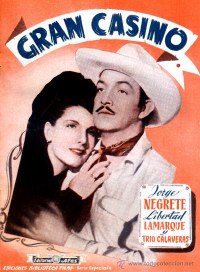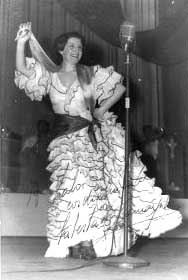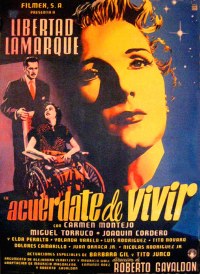LIBERTAD LAMARQUE | home
BIOGRAPHY
The Sweetheart of Latin America
by M. Omar Martínez
2019
|

Libertad Lamarque was probably the most successful popular artist to come out of Latin America in the 20th century. Her impact as a singer, actor and all around entertainer in film, stage, radio and television remains unmatched and unsurpassed by any other Latin performer. Even today, long after her death, she remains hugely popular among millions of people throughout the Americas.
IN THE BEGINNING
She was born in the city of Rosario, province of Santa Fe, in Argentina on November 24th, 1908. Her father was Gaudencio Lamarque, an immigrant from Uruguay who married Josefa Bousa, an immigrant from Spain who was a widow with seven children. Libertad was the only child of this marriage and being the youngest, she grew up surrounded by the love and care of her devoted parents and siblings. She was named Libertad (liberty or freedom), since at the time of her birth, her community activist father was serving time in jail and was obsessed with regaining his freedom. Once released, Don Gaudencio worked as a tinsmith and his wife helped with her work as a seamtress but, in spite of all the hard work, the family always lived on the verge of poverty.
As a child, everyone noticed Libertad´s natural talent for acting and singing. Her father encouraged her to perform at the many rallies and fund raisers that don Gaudencio organized for the benefit of his social agendas. At the age of 7, Lamarque won first prize for best custume at the Rosario carnival competition where she also recited a poem. From then on the girl was always asked to perform at school and at other community events.
|
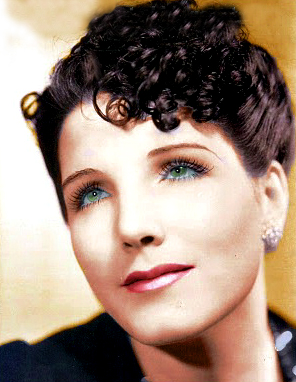 Beauty, talent and charisma!
|
 Libertad at 5 years old
|
By the time Libertad reached adolescence she was a already a seasoned performer appearing in many local stage plays. However it was in 1923 when the young actress made her professional debut in the play "Madre Tierra" which was acclaimed by critics and public alike. She attracted the atention of director José Constanzo who took her and the play on tour through the provinces. Libertad´s success convinced her parents that they should relocate to the capital city of Buenos Aires where her chances for a career would be much higher.
BUENOS AIRES AT LAST!
With a written referral by the influential journalist Pascual Carcavallo to the owner of the prestigious National Theater, Libertad, with family in tow, arrived in Buenos Aires in 1926. Mr. Carcavallo´s letter worked its magic and she was signed to a one year contract at the National, making her official debut that same year in "La muchacha de Montmartre" in a minor role.
|
Libertad´s roles became bigger with each new stage production while her fame and salary increased accordingly. It was customary at the time that, at the end of each play, there would be musical performances by invited artists or cast members for a grand finale. One night when one of the scheduled performers failed to show up, Libertad was asked to sing. She only knew one song by heart but her success was such that she had to repeat it three times.
The news that a new young vocalist had been discovered at the National made the rounds of Buenos Aires. It was not long before Libertad was invited to sing in radio broadcasts causing her voice to be heard far and wide. Soon RCA Victor wanted a piece of her action and she was signed to an exclusive recording contract. On September 26, 1926 her first 78 rpm single was released with the songs "Gaucho Sol" and "Chilenito". It must be noted that Miss Lamarque remained an exclusive recording artist for RCA for the next seventy years, an unheared of achievement in the music business.
FIRST LOVE
At 18, Libertad found her first love in the person of a fellow employee at the National Theater, Emilio Romero, a dubious character several years her senior. In spite of her parents opposition, the couple married in 1927 and, a year later, Libertad gave birth to a baby girl whom they named Mirtha. The bliss of motherhood made the young star forget the bitterness and sadness of a marriage that was doomed from the start. Soon she became a battered wife at the hands of an abusive husband. Nevertheless in 1929 she starred in a new play "El conventillo de La Paloma", an amazing box office hit that lasted for 1,000 performances. If her private life had become a tragedy, her professional life couldn´t be any better. She took the time to attend a summit of tango singers at the famed Colon Theater in Buenos Aires. It was a highly publized event attended by the major female vocalists of the day in which they would all take turns performing while the public, with its applause, would determine who was the undisputed Queen of Tango. Libertad Lamarque won by a landslide and she carried the title proudly for the rest of her life.
Her popularity singing on radio brooadcasts also earned her the title of "Queen of the radio" by popular acclaim. She had arrived!
|
 Ready to conquer Buenos Aires!
 Rehearsing with her tango musicians.
|
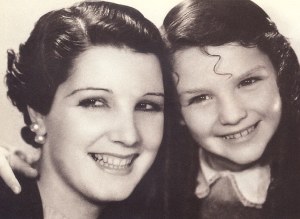 Libertad y su hija Mirtha, inseparables...
|
Sooner or later, Libertad had to face the fact of her failed marriage. The couple finally crashed at a hotel in Santiago de Chile and she attempted to commit suicide. Saved by pure luck, the incident made her decide on a divorce. Mr. Romero retaliated by kidnapping Mirtha, taking her away to Montevideo, Uruguay where his family lived. Libertad was devastated but after several weeks she devised a plan to regain her daughter. With the help of her own family and friends such as her musical collaborator Alfredo Malerva, Libertad rented a private airplane and flew to Montevideo. Showing up at the school that little Mirtha was attending, she asked the director for permission to see her. With great consternation the director and Mirtha´s teachers watch as Libertad grabbed her daughter and ran out of the school threatening anybody who would try to stop her. The getaway car was wating outside and it rushed through traffic to the airport where Libertad´s airplane had the engines running. Mother and daughter boarded the plane and soon they were safely back in Buenos Aires. The rescue operation didn´t take an hour.
However that was not the end of her troubles with Romero since he flatly refused to give her a divorce. Living in Montevideo he was unreachable to legal demands filed by his wife in Buenos Aires. Libertad had no choice but to go back to work and she did it in style with a luxurious production of the operetta "The Merry Widow" which made history at the National Theater.
|
 |
CONQUERING FILM AUDIENCES
As a restless artist Libertad was well aware of the great importance that films had acquired over the years and she had already appeared in the silent "Adios Argentina" (1929) a movie that went nowhere. It was easy to understand her enthusiasm when director Luis Cesar Amadori asked her to star in "Tango" (1933) the first Argentinian "talkie", a critical and box office success. The media hailed Miss Lamarque as "a terrific actress-singer with a great future in movie musicals".
The future did not really arrive until 1936 when Libertad starred in the film "Ayudame a Vivir" based on her own script with music by Alfredo Malerva. The film had an outstanding success not only in Argentina but all over Latin America making Libertad Lamarque an international movie star of great box-office appeal..
|
Era una reacción espontánea que no tuvo nada que ver con campañas publicitarias millonarias como las que se acostumbran en nuestros tiempos. En Cuba un periodista destacó el fenómeno refiriéndose a Libertad Lamarque como "la novia de América," un epíteto que describió con exactitud el cariño y la relación establecida con los pueblos hispanoamericanos. México aprovechó la visita de Libertad para que protagonizara, bajo la dirección de Luis Buñuel, la película Gran Casino (1946) junto a Jorge Negrete, el gran ídolo del momento y los productores mexicanos le propusieron otros proyectos para que continuara en ese país. A pesar de las tentadoras ofertas, Libertad extrañaba a su hija y a su familia por lo que decidió regresar a Buenos Aires después de un año de ausencia.
La alegría del regreso fue empañada por una extraña y disparatada situación. Las películas de Libertad estaban prohibidas, sus discos no se escuchaban en la radio y su nombre no podía mencionarse en los medios de comunicación. Estaba vetada en su propio país y rumores apuntaban a los inquilinos de la Casa Rosada como responsables. Sin comprender los motivos de la censura, Libertad y Malerba deciden lanzarse nuevamente por los caminos de América al negárseles el trabajo en la República Argentina. Cabe destacar que durante todo el tiempo que estuvieron alejados de su querido país, ni Libertad ni su esposo hicieron declaración alguna sobre los motivos que les impulsaron a abandonar Argentina, a pesar de la insistencia de periodistas y gacetilleros. En ningún momento se quejaron ni hablaron mal del gobierno argentino presidido entonces por Juan Domingo Perón y su esposa Eva. Quizás debido a ese silencio inmutable, se creó la célebre leyenda de "la cachetada" que, según el ficticio relato, había propinado Libertad a Eva durante el rodaje de La cabalgata del circo (1945).
|
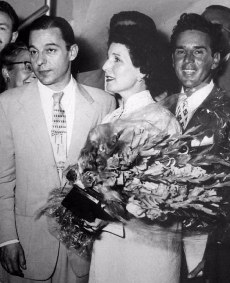 Malerba y Lamarque de viaje...
|
 Eva Duarte y Libertad en "La Cabalgata del Circo"
|
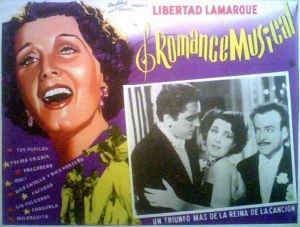 |
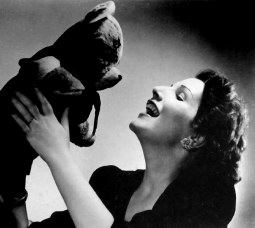 |
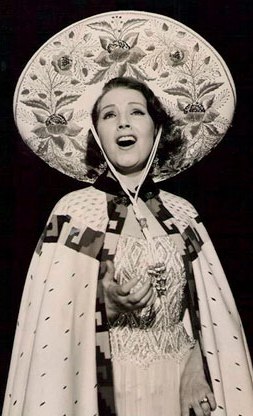 México la hizo suya...
|
México recibe a Libertad Lamarque con los brazos abiertos y la artista se establece en la capital azteca incorporánose de inmediato a la industria cinematográfica mexicana. Comenzando con Soledad (1947) Libertad se convierte en la actriz mas taquillera del cine azteca. Desde México se desplaza a cantar en otros paises como Colombia donde logra convocar a mas de 50.000 personas en el anfiteatro natural La media torta en las afueras de Bogotá. Desde ese momento, Libertad combina la actividad cinematográfica con la grabación de discos y presentaciones personales en todo el continente tanto en teatros como en emisoras de radio. Al llegar la televisión, la carrera de Libertad adquiere una nueva dimensión participando tanto en programas musicales como en telenovelas.
Se mantendría como la novia de América, mimada por los públicos, por más de 50 años sin interrupción.
|
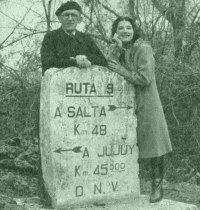 Libertad and her father during a tour of the Asrgentine provinces.
|
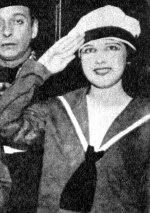 "Los Hombres de la Rivera" (1926)
|
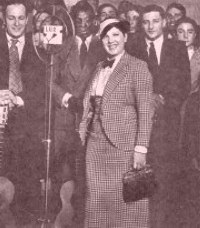 "Queen of radio" by popular acclaim.
|
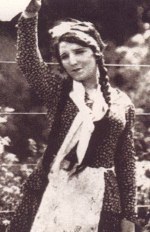 In the silent film "Adios Argentina" (1929)
|
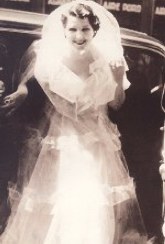 "Queen of Tango"
(1931)
|
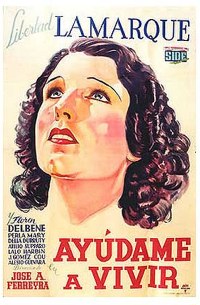 |
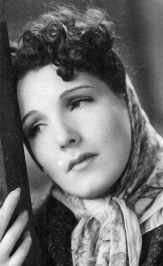 Reina del cine...
|
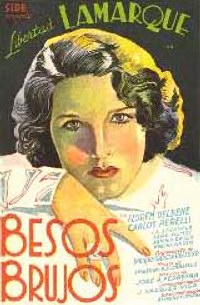 |
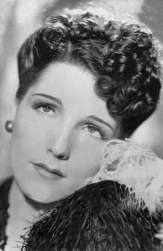 Creando una leyenda
cinematográfoca...
|
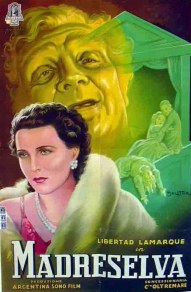 |
